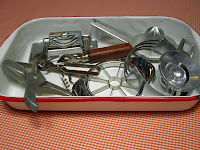If you went into any household store you would find a host of organisers…. kitchen organisers; special drawers to organise your cutlery; there are hoards of containers which only have two purposes in life, and that is to organise your cupboards and lose their lids!
This orgy of organisational equipment is designed to make it easy for you to find what you want in what is often a place of chaos.
Now, surprisingly, giving a speech is exactly the same – only you are that special organiser; and it is your job to enable your audience to find just what they want in a world of chaos. So your speech needs to be organised to ensure that they can do just that.
In a kitchen when we come to organise our equipment, we first have to find it all, and then sort it out before we can decide where to put it. Your speech needs the same treatment! You need to find all the information (research); sort it out and decide where it will go. It’s called organising your material – or organising your speech. And it is important.
Unorganised presentations or speeches leave the audience confused. They cannot sort out your main ideas, and so cannot grasp what is important. The outcome will inevitably be that you fail to achieve your objective. Remember the vital questions – why are you standing up and giving this speech? What do you want your audience to do with your carefully researched information or your emotional appeal? Whatever the answer, that is your purpose. And to achieve it you will have to get organised.
From our own experience we can tell you that if you make it too difficult for your audience to follow the logic of your argument, they will give up the attempt. If you keep swapping from one subject to another and then back again, they will give up the attempt to follow your ideas. One other thing they will do – they will lose confidence in you as a credible source of information. Once that has happened you have lost them completely. So learn how to organise your speech to ensure that your audience stays with you all the way.
Which is easy to say, but how do you ‘organise’ information to achieve your purpose?
Some speakers say that you look at your information and sort it out in order of importance – importance, that is, of getting your audience to follow your logic or to achieve your desired outcome. Now select the most important points to get there.
OK – but how do you do that! Well, just imagine that you had only three minutes to give the information; what must you absolutely cover? That, that and…. that!! There you go; the main points.
This exercise should be done, even if you are not so limited in time. If you cover too many points in a short time you will leave your audience in ‘information overload’ and if every point is given, there will be no indication of which are the really important ones.
If you are presenting to achieve a sale, or a contract, you will probably not be the only one giving a presentation – and unless you take thought for how you are going to present your information you will not stand out from the crowd. So take careful consideration for what are your absolutely essential points that must be covered if the worst happens to you – the client rushes in with the words “I’m sorry, I can only give you five minutes”
So, having determined our absolutely essential main points, our task now is to organise the order in which we present them. This is very important; we need to lead our audience to a predetermined end. We need to get somewhere and we want them to be able to follow us on the journey; and arrive at the destination in agreement.
Luckily, there are a number of ways in which we can achieve that – we call them ‘Strategic Sequencing’.
First is Chronological Sequence – where we arrange our points in a pre-determined time line. This is often referred to as ‘Past, Present and Future’. It is a very easy sequence for your listeners to follow and leads them right up to the present and the outcome you are hoping for.
The chronological sequence can also be used when describing a process or explaining how something is done or describing step by step how something works.
Because it is so specific, it is ideal for presentations to inform or to instruct.
Then we have the Spacial Sequence – which is very similar to the chronological one; only it uses placing rather than timing. So we might look at information state by state; or a building floor by floor or even a company organisational layout from the top to the bottom. Again; very useful for presenting complex information logically.
If we want to show that the situation our organisation is now facing is an outcome of certain actions, we might chose the Causal Sequence, where we outline what caused the situation and then discuss the effects and how they impact upon the organisation.
This sequence is ideal when bringing serious issues to the notice of senior executives, and can often be the preferred way of presenting findings after investigations of problems.
Closely related to that sequence is the more usual Problem Solution Sequence. The ideal sales related sequence where we identify the problem and show we have the solution.
It might be specific – ‘You have trouble with maintaining effective accounting records? Then our super software is exactly what you need!
Or it could be very general – ‘The suffering caused by addiction to gambling has a profound effect on all of us; therefore we should all support legislation to restrict access to gambling.’
This is the most often sequence used in persuasive speeches, but it must be supported with factual evidence to be truly credible.
But what if you have a presentation to give that does not fit into these categories? Then remember the kitchen organiser, where we sorted out our equipment by what they did.
When giving a speech or a presentation we can do the same, we can sort out our information into topics – and thus chose the looser (but very effective) Topical Sequence where we decide on what topics will support our main purpose.
If we want to persuade our audience to support medical research we might organise our ideas into the following topics
a. Medical research has a historically improved life expectancy
b. Medical research has often identified previously unknown problems
c. Medical research produces scientific knowledge which can be used in other disciplines.
The Topical Sequence is very flexible, and can be used to achieve a variety of outcomes; which makes it the most used of all our sequences. But, do not make the mistake of opting for it before considering if other sequences would give you a better chance to achieve your objective.
Organisation is the way to ensure that we can find what we want in potential chaos. It is the simple way we can take our listeners by the hand and lead them through the maze of arguments to arrive, together, at our chosen destination.
It should be the very first thing you do, before you get near the PowerPoint or whatever visual aid you have chosen. First organise your thoughts, then organise your speech – and only then can you organise the flourishes!
That way, you will ensure that when you give your next speech you will be getting somewhere – and somewhere that you planned to be.
Michele @ Trischel
Trischel have One Day Public Speaking Workshops coming up in Brisbane and on the Gold Coast this month.


